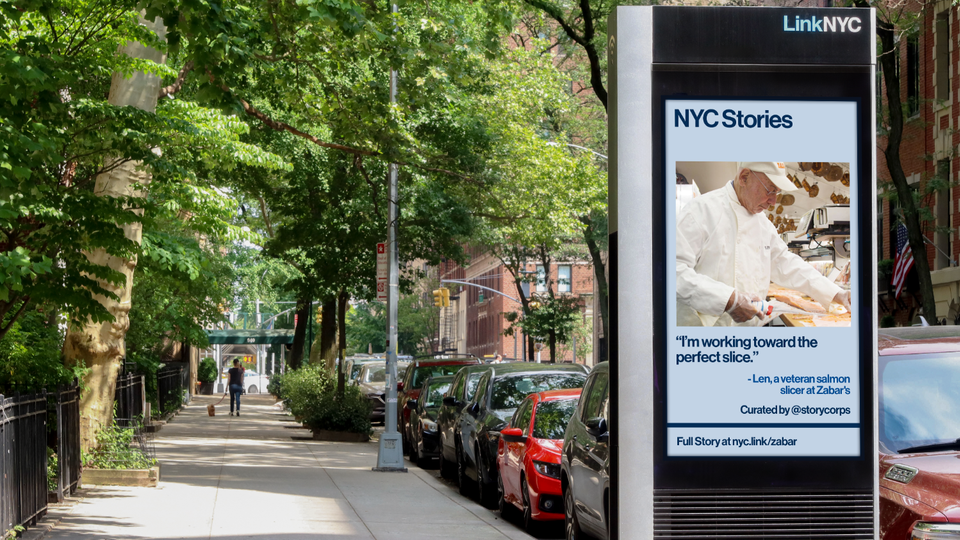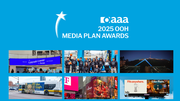Content
StoryCorps taps LinkNYC digital signage in "NYC Stories" campaign
Digital Signage Today spoke to StoryCorps and LinkNYC about their recent "NYC Stories" digital signage campaign on the LinkNYC kiosk network.

September 6, 2024 by Daniel Brown — Editor, Networld Media Group
StoryCorps, a non-profit organization dedicated to preserving American stories for the public good, has partnered with LinkNYC, which operates a network of digital kiosks across New York City, to run its "NYC Stories" summer DOOH campaign across New York City.
As reported in Digital Signage Today, the campaign highlights regular Americans and their contributions to their communities, such as New York City bus drivers who navigated the perils of the pandemic to maintain transportation services for the public.
With some individuals' stories previously featured in national venues like NPR, StoryCorps also maintains recorded interviews as part of the public record in the Library of Congress.
We reached out via email interview to learn more about the NYC campaign from Lisa Nelson-Haynes, chief program officer at StoryCorps, and Esther Raphael, CMO at Intersection.
Q&A with Lisa Nelson-Haynes, chief program officer at StoryCorps
Q: For those who don't know, can you introduce us to StoryCorps and its unique mission?
Nelson-Haynes:Founded in 2003, StoryCorps is a national nonprofit dedicated to helping us believe in each other by illuminating the humanity and possibility in us all, one story at a time. Nearly 700,000 people, in all 50 states, have recorded interviews about their lives through StoryCorps. The award-winning organization preserves the recordings in its archive at the American Folklife Center at the Library of Congress, the largest single collection of human voices ever gathered, and shares select stories with the public through StoryCorps' podcast, radio broadcasts, animated shorts, digital platforms, and best-selling books.
Q: What made the NYC Stories campaign special for your team?
Nelson-Haynes:StoryCorps was born in New York City, in Grand Central Terminal, in October 2003. While our initiatives take us to every corner of the country, New York City will always be home.
Q: What kind of impact do these campaigns have on viewers and participants in the storytelling?
Nelson-Haynes:StoryCorps interviews have always been about sitting down with someone you care about and engaging in a meaningful, 40-minute conversation. A recent survey analysis found that recording and listening to stories with StoryCorps:
- 81% of listeners said StoryCorps reminded them of our shared humanity.
- 83% of respondents felt more connected to their interview partner.
- 81% of respondents felt that they and their interview partner better understood each other.
Q: What do you see as the short- and long-term impact of the work you are doing in American cities?
Nelson-Haynes: Having celebrated its 20th anniversary in 2023, StoryCorps continues to evolve into an enduring national institution that fosters a culture of listening in the United States. In the coming years StoryCorps hopes to touch the lives of every American family, through one of our many initiatives, including:
- The Great Thanksgiving Listen encourages people of all ages to create a contemporary oral history of America by recording an interview with an elder, mentor, friend, or someone they admire.
- The Military Voices Initiative:Launched in 2012, the Military Voices Initiative provides a platform for veterans, service members, and military families to share their stories.
- The StoryCorps Mobile Tour: The StoryCorps MobileBooth, an Airstream trailer that has been transformed into a traveling recording booth, crisscrosses America year-round, gathering the stories of people nationwide.
- One Small Step (OSS) is a multi-year initiative to help bridge the divisions in our country. OSS brings together strangers with opposing political views together for a conversation—not to debate politics—but to get to know each other as people.
- Brightness in Black is a three-year initiative collecting asset-framed narratives of the expansiveness of the Black experience in America.
- StoryCorps Legacy: Since 2011, StoryCorps Legacy has provided people of all ages with serious illness—and their families—the opportunity to record, preserve, and share their stories. Learn more at storycorps.org/legacy.
Q: What led you to select LinkNYC's platform for this campaign, and how has it been working out for you so far?
Nelson-Haynes: We have a team whose work is focused on getting StoryCorps content out into the world in surprising and compelling places. For many of our participants, their interview recording is an experience they hold very dear and it's something they are thrilled and honored to share with others. Given the reach of this campaign throughout the city, we've heard from many of our participants that friends and loved ones have been reaching out to tell them they've spotted their story on a LinkNYC kiosk!
Q: What did you learn from the NYC campaign, and do you have insights or advice for advertisers?
Nelson-Haynes:Partnerships like this one with LinkNYC help to bring StoryCorps to new audiences and to invite even more participation in our work. This campaign comes at an exciting time as we have just announced the launch of a major new initiative, Brightness in Black. The three-year initiative – with support from Michael Jordan and the Jordan Brand's Black Community Commitment – will collect and amplify stories that showcase the nuance, complexity, and richness of the Black experience, challenging the pervasive narratives of Black life in America that are often limited and deficit-framed. There are a number of ways to participate in a Brightness in Black recording, either virtually or in person.
 |
LinkNYC kiosk showing "NYC Stories" content from StoryCorps. Image: LinkNYC/StoryCorps. |
Q&A with Esther Raphael, CMO at Intersection
Q: Can you tell us a little about how this collaboration came to be along with summing up the campaign for our readers?
Raphael:In 2023, StoryCorps reached out to our external affairs team to see how they could leverage their vast archive of stories to showcase the diversity of New Yorkers on the LinkNYC network around different themes, from the city's Hispanic heritage to the resilience of local military veterans and people falling in love against the backdrop of world-renowned landmarks.
As StoryCorps celebrated its 20th anniversary, along with the volume of rich content they had to share, we all agreed there was a big opportunity for us to partner on an ongoing basis and bring more tenderness, humor, and humanity to the streets of New York through LinkNYC screens.
Q: There seems to be more and more content in digital signage campaigns that is not merely advertising/promotional but inspirational. What is the place of storytelling in the DOOH space, and is this a trend to watch?
Raphael:I think it's absolutely a trend to watch. I'm confident in saying we were really one of the first media owners to create a focused content strategy that is completely separate from what we're doing on the advertising side of our business. We've definitely seen others in the industry follow suit, but perhaps not to the level that our editorial team is able to do on LinkNYC. Content is about more than just the weather, or sports scores (which are also useful and important) — it's about bringing a smile to New Yorkers through art, culture, history, humor, and so much more.
On LinkNYC, consumer content is a core part of our value proposition, and we'll always have space carved out to serve New York City communities in this way.
Q: What is it that makes digital screens like the LinkNYC ones so powerful in reaching viewers and sticking in their minds?
Raphael:About 2.9 million New Yorkers live less than a five-minute walk from a LinkNYC kiosk, and millions more pass at least one during their day in the city. Residents and visitors alike are already looking to LinkNYC screens for updates on subway times or the latest headlines, and they're likely to linger a bit longer on an intriguing piece of content — like a glimpse into the life of a lifelong New Yorker. Since consumers are already primed to engage with our screens in this way, it also gives a secondary benefit to advertisers whose messaging runs between our editorial content.
Q: Are there lessons for advertisers to take from this campaign?
Raphael:Campaigns that feature content viewers can relate to — language and visuals that surprise people or make them laugh — can make the difference between an ad that fades into the rest of the cityscape, and one that speaks directly to passersby. Content that reflects our humanity and invites us to interact with each other on a more personal level has a much higher probability of earning more meaningful engagement.
Q: What does this campaign show about the future of OOH media?
Raphael:I feel that this campaign from StoryCorps, especially, demonstrates that OOH media has endless potential to communicate creatively with urbanites from every walk of life. StoryCorps' content on LinkNYC screens blurs the line between engaging with our neighbors in virtual and physical spaces — which makes the campaign special. As the industry continues to innovate, I think we'll see more and more campaigns (both advertising and content) finding ways to stand out by offering something surprising for viewers, whether it's playful, candid, or unexpectedly human to the point that people can't help but be absorbed by it.
About Daniel Brown
Daniel Brown is the editor of Digital Signage Today, a contributing editor for Automation & Self-Service, and an accomplished writer and multimedia content producer with extensive experience covering technology and business. His work has appeared in a range of business and technology publications, including interviews with eminent business leaders, inventors and technologists. He has written extensively on AI and the integration of technology and business strategy with empathy and the human touch. Brown is the author of two novels and a podcaster. His previous experience includes IT work at an Ivy League research institution, education and business consulting, and retail sales and management.







